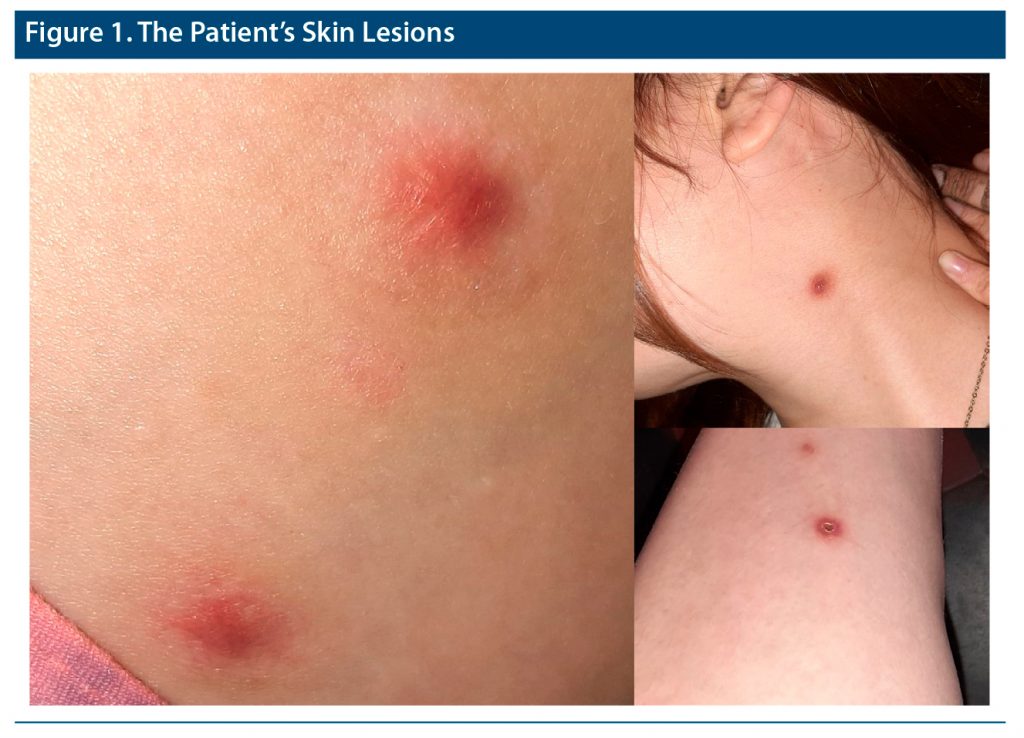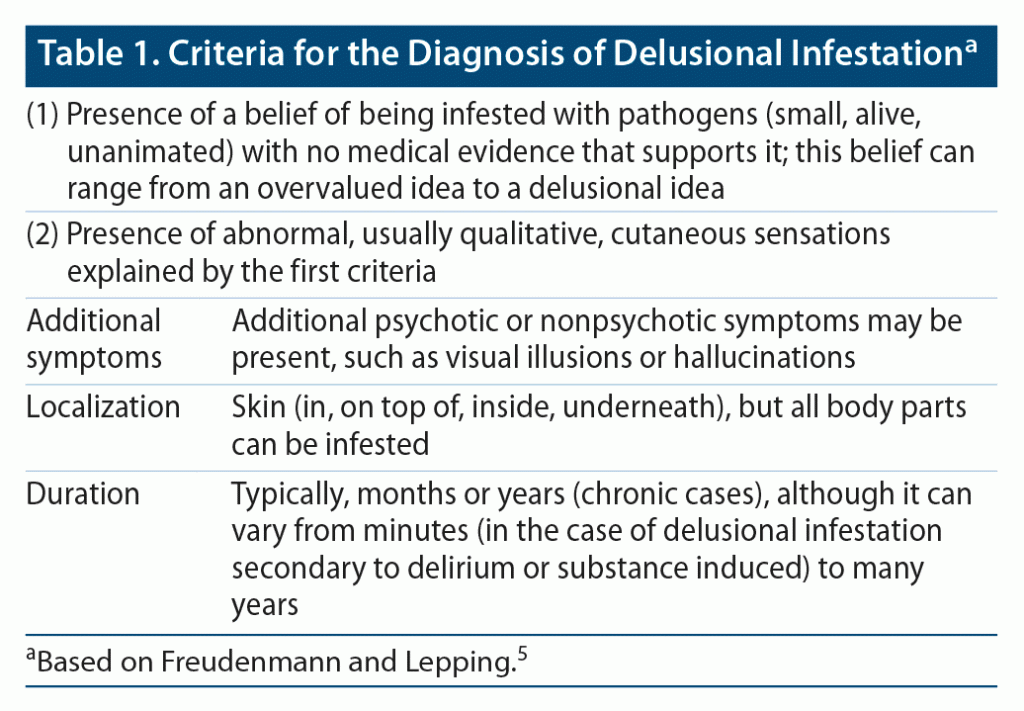
Prim Care Companion CNS Disord 2022;24(2):21cr03019
To cite: Torales J, Almirón-Santacruz J, Barrios I, et al. “Cocaine bugs”: implications for primary care providers. Prim Care Companion CNS Disord. 2022;24(2):21cr03019.
To share: https://doi.org/10.4088/PCC.21cr03019
© Copyright 2022 Physicians Postgraduate Press, Inc.
aDepartment of Psychiatry, School of Medical Sciences, National University of Asunción, San Lorenzo, Paraguay
bDepartment of Psychiatry, Central Michigan University, Mount Pleasant, Michigan
cDepartment of Neuroscience, Medical School, Fundação do ABC, Santo André, Brazil
dDepartment of Psychiatry, Medical School, University of São Paulo, São Paulo, Brazil
eDepartment of Clinical and Experimental Medicine, University of Foggia, Foggia, Italy
*Corresponding author: Julio Torales, MSc, Department of Psychiatry, School of Medical Sciences, National University of Asunción, Avda. Mariscal López y Coronel Cazal, Campus de la UNA, San Lorenzo, Paraguay ([email protected]).
Delusional infestation is characterized by the presence of a delusional idea in which the body, mainly the skin, is infested by small pathogens in absence of any medical evidence.1–6 Patients show self-destructive behaviors in effort to get rid of skin pathogens, generating excoriations, ulcerations, and secondary infections.7,8 Patients usually seek help from their general practitioner or dermatologist and as a last resort from psychiatrists.9
Apart from a primary form, delusional infestation may be associated with other psychiatric disorders (secondary functional forms), as well as medical diseases or substance abuse (secondary organic forms).10 We present a case of delusional infestation in a patient with a history of cocaine use. The disorder remitted after withdrawal of cocaine and administration of an antipsychotic agent.
Case Report
A 34-year-old married female lawyer and mother of a 3-year-old girl underwent a psychiatric consultation. She reported intense itching and strange sensations under her skin in the last month. The itching had been affecting all body sites with severe scratching. Previously, a general practitioner prescribed topical antibiotics for the presence of infected lesions. She also began experiencing severe anxiety and insomnia, leading her to consult a psychiatrist.
During the assessment, the patient reported seeing small spiders at the bottom of the skin lesions. She had previously used pliers and pointed objects to remove them, deepening the lesions. Our physical examination excluded signs of infestation. She reported using cocaine for 7 years (Figure 1). The diagnosis of secondary organic delusional infestation was made according to the diagnostic criteria of Freudenmann and Lepping5 (Table 1).
Risperidone 3 mg/d, clonazepam 2 mg/d, and hydroxyzine 50 mg 3 times/d were prescribed, the latter to reduce pruritus. Urinary toxicologic screening was positive for cocaine 1 week later, and the patient was then referred to the addiction clinic.
After a month of treatment, the patient began to question the delusional idea of infestation. After 2 months, she completely denied this idea, and the lesions improved. She has been abstinent from cocaine for 3 months and is still taking risperidone 3 mg/d and receiving psychotherapy.
Discussion
Delusional infestation can start with a cutaneous sensorial misinterpretation that turns into a tactile hallucination and consolidates into a delusional idea.11 It has been proposed that a dopaminergic deregulation contributes to the onset of the delusional condition in primary forms.12 Secondary forms of delusional infestation are due to a consumption of dopamine transporter inhibitors (cocaine, pemoline, bupropion, amphetamines) or to secondary dysfunctions of the dopamine transporter (traumatic brain injury, Parkinson disease, schizophrenia).13–15 The illness onset occurs between age 55 and 68 years,8,9 although it may occur in adolescents and young adults after abuse of substances such as cocaine or amphetamines.16,17 Also, cocaine may lead to vasculitis, skin infection, and formication (tactile hallucinations of insects crawling underneath the skin), possibly inducing delusional infestation and other psychosis-related dermatologic disorders.16,18
Antipsychotic treatments are recommended.7 Risperidone (1–8 mg/d) and olanzapine (5–10 mg/d) are mostly used with positive outcomes.19,20 Secondary delusional infestation treatment may also be based on the resolution of the underlying comorbid disease or substance abuse.20,21 An adjuvant psychological approach, mainly cognitive-behavioral therapy, is also recommended.22
Substance-induced delusional infestation may have an abrupt onset, and prognosis generally relies on prompt diagnosis and appropriate treatments.5 Primary care providers and dermatologists should involve mental health care professionals in the assessment of patients.1 With appropriate treatments, a good prognosis with remission has been reported in up to 75% of cases; however, cases of comorbid organic disease have shown poor outcomes.2
Published online: February 24, 2022.
Potential conflicts of interest: None.
Funding/support: None.
Patient consent: Written and informed consent was received from the patient to publish this case report, and information was de-identified to protect anonymity.
References (22)

- Torales J. Delusional Infestations. In: Bhugra D, Malhi G, eds. Troublesome Disguises: Managing Challenging Disorders in Psychiatry. 2nd ed. London: Wiley Blackwell; 2015:252–261.
- Torales J, González L, Ruiz Díaz C, et al. Delirio de Infestación. In: Torales J, Malatesta E, eds. Psicodermatología: una Actualización Diagnóstica y Terapéutica de las Entidades Clínicas Más Frecuentes [Psychodermatology: a Diagnostic and Therapeutic Update of the Most Frequent Clinical Entities]. 1st ed. Asunción: EFACIM; 2019:62–79.
- Koo J, Lebwohl A. Psychodermatology: the mind and skin connection. Am Fam Physician. 2001;64(11):1873–1878. PubMed
- Heller MM, Wong JW, Lee ES, et al. Delusional infestations: clinical presentation, diagnosis and treatment. Int J Dermatol. 2013;52(7):775–783. PubMed CrossRef
- Freudenmann RW, Lepping P. Delusional infestation. Clin Microbiol Rev. 2009;22(4):690–732. PubMed CrossRef
- Revelli C, Pichon M, Cambazard F, et al. Consultation dermato-psychiatrique [Dermato-psychiatric consultation]. Ann Dermatol Venereol. 2002;129(5 Pt 1):742–745. PubMed
- Torales J, García O, Barrios I, et al. Delusional infestation: clinical presentations, diagnosis, and management. J Cosmet Dermatol. 2020;19(12):3183–3188. PubMed CrossRef
- Torales J, Arce, A, Bolla L, et al. Delirio parasitario dermatozoico: reporte de un caso [Dermatozoic parasitic delirium: a case report]. An Fac Cienc Med (Asuncion). 2011;44(2):81–87.
- González L, Torales J, Arce A, et al. Síndrome de Ekbom. A propósito de un caso [Ekbom syndrome: a case report]. Act Terap Dermatol. 2010;33:140–145.
- Vulink NC. Delusional infestation: state of the art. Acta Derm Venereol. 2016;96(217):58–63. PubMed CrossRef
- Al-Imam AML. A systematic literature review on delusional parasitosis. J Dermatol Surg. 2016;20(1):5–14. CrossRef
- Huber M, Karner M, Kirchler E, et al. Striatal lesions in delusional parasitosis revealed by magnetic resonance imaging. Prog Neuropsychopharmacol Biol Psychiatry. 2008;32(8):1967–1971. PubMed CrossRef
- Millard LG, Millard J. Psychocutaneous disorders. In: Burns T, Breathnach S, Cox N, et al, eds. Rook’s Textbook of Dermatology. 8th ed. Oxford: Wiley-Blackwell; 2010:3281–3284.
- Huber M, Kirchler E, Karner M, et al. Delusional parasitosis and the dopamine transporter. a new insight of etiology? Med Hypotheses. 2007;68(6):1351–1358. PubMed CrossRef
- Reich A, Kwiatkowska D, Pacan P. Delusions of parasitosis: an update. Dermatol Ther (Heidelb). 2019;9(4):631–638. PubMed CrossRef
- Elliott A, Mahmood T, Smalligan RD. Cocaine bugs: a case report of cocaine-induced delusions of parasitosis. Am J Addict. 2012;21(2):180–181. PubMed CrossRef
- Fisher AH, Stanciu CN. Amphetamine-induced delusional infestation. Am J Psychiatry Resid J. 2017;12(12):12–13. CrossRef
- Brewer JD, Meves A, Bostwick JM, et al. Cocaine abuse: dermatologic manifestations and therapeutic approaches. J Am Acad Dermatol. 2008;59(3):483–487. PubMed CrossRef
- Freudenmann RW, Lepping P. Second-generation antipsychotics in primary and secondary delusional parasitosis: outcome and efficacy. J Clin Psychopharmacol. 2008;28(5):500–508. PubMed CrossRef
- Torales J, Melgarejo O, González I, et al. Psychopharmacology in dermatology: treatment of primary psychiatric conditions in dermatology. Dermatol Ther (Heidelb). 2020;33(4):e13557. PubMed CrossRef
- Campbell EH, Elston DM, Hawthorne JD, et al. Diagnosis and management of delusional parasitosis. J Am Acad Dermatol. 2019;80(5):1428–1434. PubMed CrossRef
- Jalali Roudsari M, Chun J, Manschreck TC. Current treatments for delusional disorder. Curr Treat Options Psychiatry. 2015;2(2):151–167. CrossRef
Please sign in or purchase this PDF for $40.






